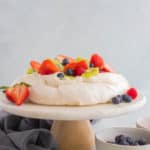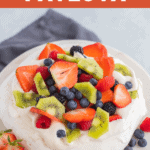 Buy Now →
Buy Now → Pavlova
Experience the perfect balance of sweetness and texture with this classic pavlova recipe. With a crispy crust and a soft, marshmallow-like center, it's a simple yet beautiful dessert that will delight your taste buds!
- Prep Time: 20 minutes
- Resting Time: 5 hours
- Cook Time: 90 minutes
- Total Time: 6 hours 50 minutes
- Yield: 8 servings 1x
- Category: Dessert
- Method: Oven
- Cuisine: Austrailian
- Diet: Gluten Free
Ingredients
- 4 egg whites (use the yolks for lemon curd or tiramisu!)
- 1 cup granulated sugar
- 1 teaspoon pure vanilla extract
- 1/2 teaspoon cream of tartar (or 1 teaspoon lemon juice or vinegar)
- 1 tablespoon cornstarch
Instructions
1. Preheat the oven to 350F. Line a baking sheet with parchment paper (draw a 7-8 inch circle on the paper.)
2. Using a hand mixer or stand mixer fitted with a whisk attachment, beat the egg whites and vanilla extract on medium speed until soft peaks form (the peak slowly collapses on itself.)
3. Add in the sugar, half a cup at a time, and continue beating until glossy, stiff peaks form and the sugar is dissolved (it should no longer feel gritty.) The peaks should be very stiff at this point. If not, continue mixing at high speed until they have reached a stiff consistency (when the beaters or whisk are lifted up, the peak doesn’t move.)
4. Use a spatula to scrape the bowl and gently fold in the cream of tartar and cornstarch. Fold until all of the powder is absorbed, taking care not to overfold the meringue.
5. Transfer the meringue to the prepared baking sheet. Use a spatula to create tall edges and a slight depression in the middle.
6. Place the pavlova in the oven and immediately reduce the heat to 200F. Bake for 90 minutes or until the pavlova is firm and dry to the touch; it will turn a slight cream color.
7. Turn the oven off and let the pavlova cool inside the oven. Allow it to cool for at least 5-6 hours or overnight, which will help prevent it from cracking (although some cracking is normal.)
8. Just before serving, top with whipped cream and fresh fruit.
Notes
- Cool the pavlova in the oven. Allowing the pavlova to gradually cool in the oven will prevent cracks and also prevent it from collapsing.
- Don't make it on a humid day. Meringue is full of sugar, so if the humidity is high when you make pavlova it will absorb moisture in the air. This will make the meringue weep or it will go soft and sticky after baking.
- Work with a clean bowl and avoid egg yolks. Traces of fat or oil on the bowl or beaters, as well as bits of egg yolk, can prevent how well your egg whites whip.
- Plan ahead. Yes, it's easy to make, but pavlova isn't a dessert you'll have on the table in a matter of minutes. Pavlova has to cool in the oven for several hours, so make sure you give yourself plenty of time before the dessert needs to be served.
- Garnish just before serving. Store the pavlova, un-topped in an airtight container until ready to serve. Anything moist dissolves the meringue, like whipped cream or fresh fruits. Then, just before serving, add the toppings.
- **Nutrition facts have been calculated without the addition of any toppings.**
Nutrition
- Serving Size:
- Calories: 89
- Sugar: 0.7 g
- Sodium: 27.6 mg
- Fat: 5.5 g
- Carbohydrates: 4.2 g
- Fiber: 1.5 g
- Protein: 4.8 g
- Cholesterol: 0 mg
Find it online: https://wanderzestblog.com/pavlova/



